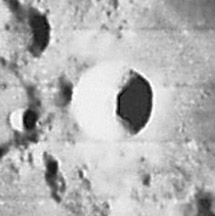Hill
Contents
Hill
(formerly Macrobius B)
|
Lat: 20.9°N, Long: 40.8°E, Diam: 15.76 km, Depth: 3.83 km, Rükl: 25 |
Images
LPOD Photo Gallery Lunar Orbiter Images Apollo Images (note: all orbital Apollo photographs of Hill are online as Macrobius B)
- AS15-87-11703 is the last one of three spectacular orbital Hasselblads which show both Hill' (foreground) and Carmichael (background). Looking south-southwest. The bowl-shaped crater near the horizon is Theophrastus. The odd bell-shaped objects at the left margin of this photograph are two of LM Falcons small exhaust nozzles. - DannyCaes Dec 27, 2007
Maps
(LAC zone 43C1) LAC map Geologic map LTO map
Description
Wikipedia
Additional Information
- IAU page: Hill
- Depth data from Kurt Fisher database
- Westfall, 2000: 3.83 km
- Viscardy, 1985: 3.34 km
- Included in ALPO list of bright ray craters
Nomenclature
- Named for George William Hill (March 3, 1838 – April 16, 1914), a U.S. astronomer and mathematician. His work focused on the mathematics describing the three-body problem, later the four-body problem, to calculate the orbits of the Moon around the Earth, as well as that of planets around the Sun. The Hill sphere, which approximates the gravitational sphere of influence of one astronomical body in the face of perturbations from another heavier body around which it orbits, was described by Hill. Hill was the 1909 Bruce Medalist of the Astronomical Society of the Pacific and extensive links to information about him can be found there.
- Hill was not part of the original IAU nomenclature of Named Lunar Formations but it appears in the cumulative list of lunar names published in IAU Transactions XVB (1973). Exactly when and how it was added is unclear, nor is the honoree designated. Biographical information was unofficially reported in Ashbrook, 1974.
- The name Hill next appears, as a replacement for Macrobius B, on LTO 43C1 (May 1974), for which it serves as the title.
- In their book The Moon, Percy Wilkins and Patrick Moore called southern hemisphere crater Lockyer H' "'Hill".
- Harold Hill (1920-2005), author of A Portfolio of Lunar Drawings. - DannyCaes Jan 14, 2014
LPOD Articles
Bibliography
Of messrs. Hill and Ihle, and M 22 slightly south of the ecliptic; on the moon's path
There's this curious Hill-thing on page 1596 of Burnham's Celestial Handbook (Volume 3) :
- The discovery of the globular star cluster Messier 22 in the constellation Sagittarius is usually credited to the obscure German astronomer Abraham Ihle in 1665. Virtually nothing appears to be known about Ihle, however, and it has even been suggested that the name is a misprint for "Hill". Admiral Smyth mentions the fact that an Abraham Hill was a member of the first council of the British Royal Society, "and was wont to dabble with astronomy... Hevelius, however, appears to have noticed it (Messier 22) previous to 1665".
Johann Abraham Ihle (1627-1699).
Abraham Hill (1633-1721).
- The location of Messier 22 is slightly southward of the ecliptic, which means it could be occulted by the moon. Perhaps there are photographs of both Messier 22's central core and the dark part of the moon near or at it, in which the limb of the moon's nocturnal part is blocking the light of thousands of stars, disappearing one by one during Waxing Moon, or reappearing during Waning Moon!
- DannyCaes May 17, 2015
Named Featues -- Prev: Hilbert -- Next: Hind
